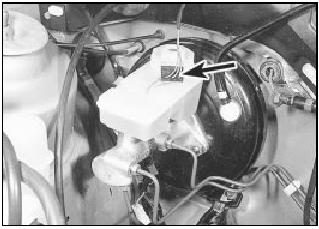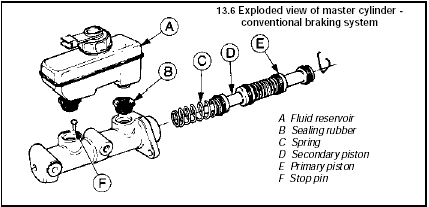Master cylinder (conventional braking system) - removal, overhaul and refitting
Note: Before commencing overhaul obtain a repair kit containing new pistons and seals.
Caution: Refer to the
precautions in Section 1.
Removal
1 Depress the brake pedal several times to
dissipate the vacuum in the servo.
2 Disconnect the wiring plug from the low fluid level switch on the fluid reservoir cap (see illustration).

13.2 Disconnect the wiring plug from the low fluid level switch (arrowed)
3 Place a suitable container beneath the master cylinder, then unscrew the union nuts and disconnect the two fluid pipes. Plug the ends of the pipes to prevent dirt ingress.
4 Unscrew the two mounting nuts and spring washers, and withdraw the master cylinder from the servo. Cover the master cylinder with rag or a plastic bag to prevent spillage of hydraulic fluid on the vehicle paintwork. If fluid is accidentally spilt on the paintwork, wash off immediately with cold water.
Overhaul
5 Drain the remaining fluid from the master
cylinder, and clean the exterior surfaces with
methylated spirit.
6 Pull the fluid reservoir from the top of the master cylinder and prise out the sealing rubbers (see illustration).

13.6 Exploded view of master cylinder - conventional braking system
A Fluid reservoir
B Sealing rubber
C Spring
D Secondary piston
E Primary piston
F Stop pin
7 Mount the master cylinder in a vice, then depress the primary piston slightly and extract the circlip and washer. Withdraw the primary piston assembly.
8 Depress the secondary piston and remove the stop pin from the fluid aperture.
9 Remove the master cylinder from the vice and tap it on the bench to remove the secondary piston assembly.
10 Prise the seals from the secondary piston.
Do not attempt to dismantle the primary piston.
11 Clean all the components in methylated spirit and examine them for wear and damage. In particular check the surfaces of the pistons and cylinder bore for scoring and corrosion. If the cylinder bore is worn, renew the complete master cylinder, otherwise obtain a repair kit including pistons and seals.
12 Check that the fluid inlet and outlet ports are free and unobstructed. Dip the new pistons and seals in clean brake fluid.
13 Fit the seals to the secondary piston using the fingers only to manipulate them into the grooves. Note that the sealing lips must face away from each other.
14 Insert the secondary piston and spring into the cylinder. Turn the piston slowly as the first seal enters to avoid trapping the sealing lip. Similarly insert the primary piston and spring, then fit the washer and circlip.
15 Depress the primary and secondary pistons and refit the secondary piston stop pin.
16 Fit the fluid reservoir sealing rubbers and press the reservoir into them. If the rubbers are worn or perished, or if leakage has been evident, fit the new rubbers.
Refitting
17 Refitting is a reversal of removal but
tighten the mounting nuts and pipe union nuts
to the specified torque and finally bleed the
hydraulic system.
See also:
Rear tie-bar (Saloon and Estate models) - removal and refitting
Removal
1 Before attempting to remove a tie-bar, note
the location of all washers and bushes. These
control the rear wheel alignment and they
must be returned to their original locations.
2 Raise ...
Fuel and exhaust systems - fuel injection
General information and precautions
General information
2.0 litre SOHC models
The fuel injection system fitted to these
models is of the Bosch L-Jetronic type. The
system is under the overall con ...
Specifications
Front suspension
Type . . . . . . . . . . . . . . . . . . . . . . . . . . . . . . . . . . . . . .
. . . . . . . . . . . . . . Independent by MacPherson struts with coil springs
and
integral tele ...
